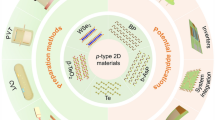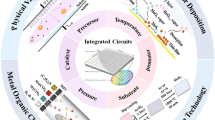Abstract
First-principles calculations have been performed to investigate the geometric and electronic properties of stanene layer paired with monolayer MoS2 substrate with van der Waals corrections. It is found that the stanene can absorb on the monolayer MoS2 substrate forming stanene/MoS2 heterostructures, indicating a weak interface interaction. The Dirac point of stanene is still preserved on MoS2 substrate, and the band gap is opened about 67 meV due to the influence of the substrate. Moreover, the band gap is able to be effectively modulated under an external strain and a perpendicular electric field. These results are helpful for exploring the tunability of the electronic properties of stanene absorbed on semiconducting substrate.







Similar content being viewed by others
References
Vogt P, Padova PD, Quaresima C, Avila J, Frantzeskakis E, Asensio MC, Lay GL (2012) Silicene: compelling experimental evidence for graphenelike two-dimensional silicon. Phys Rev Lett 108(15):5501–5505
Dávila ME, Xian L, Cahangirov S, Rubio A, Lay GL (2014) Germanene: a novel two-dimensional germanium allotrope akin to graphene and silicene. New J Phys 16(9):5002–5011
Xu Y, Yan B, Zhang HJ, Wang J, Xu G, Tang P, Zhang SC (2013) Large-gap quantum spin Hall insulators in tin films. Phys Rev Lett 111(13):6804–6808
Wang M, Liu L, Liu CC, Yao Y (2016) van der Waals heterostructures of germanene, stanene, and silicene with hexagonal boron nitride and their topological domain walls. Phys Rev B 93(15):5412–5419
Zhu FF, Chen WJ, Xu Y, Gao CL, Guan DD, Liu CH, Jia JF (2015) Epitaxial growth of two-dimensional stanine. Nat Mater 14:1020–1025
X. Qian, Y. Wang, W. Li, J. Lu, J. Li (2015) Modelling of stacked 2D materials and devices. 2D Mater 2(3): 2003
Wang Y, Ni Z, Liu Q, Quhe R, Zheng J, Ye M, Lu J (2015) All-metallic vertical transistors based on stacked dirac materials. Adv Funct Mater 25(1):68–77
Zhu J, Schwingenschlögl U (2015) Stability and electronic properties of silicene on WSe2. J Mater Chem C 3(16):3946–3953
Shao L, Chen G, Ye H, Wu Y, Niu H, Zhu Y (2014) Electronic properties of MoS2 sandwiched between graphene monolayers. EPL-Europhys Lett 106(4):7003–7008
Gao N, Li JC, Jiang Q (2014) Tunable band gaps in silicone-MoS2 heterobilayers. Phys Chem Chem Phys 16(23):11673–11678
Li X, Wu S, Zhou S, Zhu Z (2014) Structural and electronic properties of germanene/MoS2 monolayer and silicene/MoS2 monolayer superlattices. Nanoscale Res Lett 9:110–118
Yu L, Lee YH, Ling X, Santos EJ, Shin YC, Lin Y, Palacios T (2014) Graphene/MoS2 hybrid technology for large-scale two-dimensional electronics. Nano Lett 14(6):3055–3063
Li XD, Wu SQ, Zhu ZZ (2015) Band gap control and transformation of monolayer-MoS2-based hetero-bilayers. J Mater Chem C 3(36):9403–9411
Kresse G, Furthmüller J (1996) Efficiency of ab initio total energy calculations for metals and semiconductors using a plane-wave basis set. Comp Mater Sci 6:15–50
Halgren TA (1992) The representation of van der Waals (vdW) interactions in molecular mechanics force fields: potential form, combination rules, and vdW parameters. J Am Chem Soc 114(20):7827–7843
Perdew JP, Burke K, Ernzerhof M (1996) Generalized gradient approximation made simple. Phys Rev Lett 78(7):1396
Modarresi M, Kakoee A, Mogulkoc Y, Roknabadi MR (2015) Effect of external strain on electronic structure of stanene. Comp Mater Sci 101:164–167
Lebegue S, Eriksson O (2009) Electronic structure of two-dimensional crystals from ab initio theory. Phys Rev B 79(11):5409
Hu W, Li Z, Yang J (2013) Structural, electronic, and optical properties of hybrid silicene and graphene nanocomposite. J Chem Phys 139(15):4704
Hu W, Wang T, Yang J (2014) Tunable Schottky contacts in hybrid graphene–phosphorene nanocomposites. J Mater Chem A 3(18):4756–4761
Cai Y, Chuu CP, Wei CM, Chou MY (2013) Stability and electronic properties of two-dimensional silicene and germanene on graphene. Phys Rev B 88(24):5408
Neek-Amal M, Sadeghi A, Berdiyorov GR, Peeters FM (2013) Realization of free-standing silicene using bilayer graphene. Appl Phys Lett 103(26):1904
Li SS, Zhang CW, Ji WX (2015) Novel electronic properties in silicene on MoSe2 monolayer: an excellent prediction for FET. Mater Chem Phy 164:150–156
Kadantsev ES, Hawrylak P (2012) Electronic structure of a single MoS2 monolayer. Solid State Commun 152(10):909–913
Liu X, Li Z (2015) Electric field and strain effect on graphene-MoS2 hybrid structure: ab initio calculations. J Phys Chem Lett 6(16):3269–3275
Li W, Wang T, Dai X, Wang X, Zhai C, Ma Y, Chang S (2016) Bandgap engineering of different stacking WS2 bilayer under an external electric field. Solid State Commun 225:32–37
Yan JA, Gao SP, Stein R, Coard G (2015) Tuning the electronic structure of silicene and germanene by biaxial strain and electric field. Phys Rev B 91(24):5403
Li XR, Dai Y, Ma YD, Liu QQ, Huang BB (2015) Intriguing electronic properties of two-dimensional MoS2/TM2CO2 (TM = Ti, Zr, or Hf) hetero-bilayers: type-II semiconductors with tunable band gaps. Nanotechnology 26(13):5703–5709
Li YF, Chen ZF (2014) Tuning electronic properties of germanane layers by external electric field and biaxial tensile strain: a computational study. J Phys Chem C 118(2):1148–1154
Khoo KH, Mazzoni MSC, Louie SG (2004) Tuning the electronic properties of boron nitride nanotubes with transverse electric fields: a giant dc Stark effect. Phys Rev B 69(20):1401–1403
Park CH, Louie Steven G (2008) Energy gaps and stark effect in boron nitride nanoribbons. Nano Lett 8(8):2200–2203
Ramasubramaniam A, Naveh D, Towe E (2011) Tunable band gaps in bilayer transition-metal dichalcogenides. Phys Rev B 84(20):5325–5334
Liu QH, Li LZ, Li YF, Gao ZX, Chen ZF, Lu J (2012) Tuning electronic structure of bilayer MoS2 by vertical electric field: a first-principles investigation. J Phys Chem C 116(40):21556–21562
Zhou S, Zhao JJ (2016) Electronic structures of germanene on MoS2: effect of substrate and molecular adsorption. J Phys Chem C 120(38):21691–21698
Acknowledgements
This work was supported by the National Natural Science Foundation of China (No. 61675032), the National Basic Research Program of China (973 Program) under Grant No. 2014CB643900, the Open Program of State Key Laboratory of Functional Materials for Informatics, and the Shanghai Pujiang Program (Grant No. 14PJ1410600).
Author information
Authors and Affiliations
Corresponding author
Rights and permissions
About this article
Cite this article
Liang, D., He, H., Lu, P. et al. Tunable band gaps in stanene/MoS2 heterostructures. J Mater Sci 52, 5799–5806 (2017). https://doi.org/10.1007/s10853-017-0817-z
Received:
Accepted:
Published:
Issue Date:
DOI: https://doi.org/10.1007/s10853-017-0817-z




